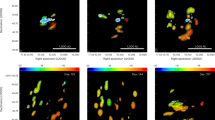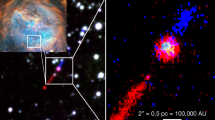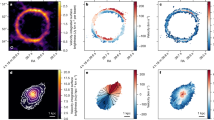Abstract
Hydrodynamical simulations show that a pair of spiral arms can form in the disk around a rapidly growing young star and that the arms are crucial in transporting angular momentum as the disk accretes material from the surrounding envelope1,2,3,4. Here we report the detection of a pair of symmetric spiral structures in a protostellar disk, supporting the formation of spiral arms in the disk around a forming star. The HH 111 VLA 1 source is a young Class I source embedded in a massive infalling protostellar envelope and is actively accreting, driving the prominent HH 111 jet. Previous observations showed a ring of shock emission around the disk’s outer edge5, indicating accretion of the envelope material onto the disk at a high rate. Now with ALMA observations of thermal emission from dust particles, we detect a pair of spiral arms extending from the inner region to the disk’s outer edge, similar to that seen in many simulations1,2,3,4. Additionally, the disk is massive, with a Toomre Q parameter near unity in the outer parts where the spiral structures are detected, supporting the notion that envelope accretion is making the outer disk gravitationally unstable. In our observations, another source, HH 111 VLA 2, is spatially resolved for the first time, showing a disk-like structure with a diameter of ~26 au and an orientation nearly orthogonal to that of the HH 111 VLA 1 disk.
This is a preview of subscription content, access via your institution
Access options
Access Nature and 54 other Nature Portfolio journals
Get Nature+, our best-value online-access subscription
$29.99 / 30 days
cancel any time
Subscribe to this journal
Receive 12 digital issues and online access to articles
$119.00 per year
only $9.92 per issue
Buy this article
- Purchase on Springer Link
- Instant access to full article PDF
Prices may be subject to local taxes which are calculated during checkout



Similar content being viewed by others
Data availability
This Letter makes use of the following ALMA data: ADS/JAO.ALMA#2015.1.00037.S and 2017.1.00044.S. The data that support the plots within this paper and other findings of this study are available from the corresponding author on reasonable request.
References
Bate, M. R. Collapse of a molecular cloud core to stellar densities: the first three-dimensional calculations. Astrophys. J. Lett. 508, L95–L98 (1998).
Rice, W. K. M., Armitage, P. J., Bate, M. R. & Bonnell, I. A. The effect of cooling on the global stability of self-gravitating protoplanetary discs. Mon. Not. R. Astron. Soc. 339, 1025–1030 (2003).
Tomida, K., Machida, M. N., Saigo, K., Tomisaka, K. & Matsumoto, T. Exposed long-lifetime first core: a new model of first cores based on radiation hydrodynamics. Astrophys. J. Lett. 725, L239–L244 (2010).
Harsono, D., Alexander, R. D. & Levin, Y. Global gravitational instabilities in discs with infall. Mon. Not. R. Astron. Soc. 413, 423–433 (2011).
Lee, C.-F., Hwang, H.-C. & Li, Z.-Y. Angular momentum loss in the envelope–disk transition region of the HH 111 protostellar system: evidence for magnetic braking? Astrophys. J. 826, 213 (2016).
Pérez, L. M. et al. Spiral density waves in a young protoplanetary disk. Science 353, 1519–1521 (2016).
Andrews, S. M. et al. The disk substructures at high angular resolution project (DSHARP). I. Motivation, sample, calibration, and overview. Astrophys. J. Lett. 869, L41 (2018).
Huang, J. et al. The disk substructures at high angular resolution project (DSHARP). III. Spiral structures in the millimeter continuum of the Elias 27, IM Lup, and WaOph 6 disks. Astrophys. J. Lett. 869, L43 (2018).
Kurtovic, N. T. et al. The disk substructures at high angular resolution project (DSHARP). IV. Characterizing substructures and interactions in disks around multiple star systems. Astrophys. J. Lett. 869, L44 (2018).
Hall, C. et al. Is the spiral morphology of the Elias 2–27 circumstellar disc due to gravitational instability? Mon. Not. R. Astron. Soc. 477, 1004–1014 (2018).
Meru, F. et al. On the origin of the spiral morphology in the Elias 2–27 circumstellar disk. Astrophys. J. Lett. 839, L24 (2017).
Forgan, D. H., Ilee, J. D. & Meru, F. Are Elias 2–27’s spiral arms driven by self-gravity, or by a companion? A comparative spiral morphology study. Astrophys. J. Lett. 860, L5 (2018).
Toomre, A. On the gravitational stability of a disk of stars. Astrophys. J. 139, 1217–1238 (1964).
Gammie, C. F. Nonlinear outcome of gravitational instability in cooling, gaseous disks. Astrophys. J. 553, 174–183 (2001).
Tobin, J. J. et al. A triple protostar system formed via fragmentation of a gravitationally unstable disk. Nature 538, 483–486 (2016).
Alves, F. O. et al. Molecular outflow launched beyond the disk edge. Astron. Astrophys. 603, L3 (2017).
Tomida, K., Machida, M. N., Hosokawa, T., Sakurai, Y. & Lin, C. H. Grand-design spiral arms in a young forming circumstellar disk. Astrophys. J. Lett. 835, L11 (2017).
Turner, N. J. et al. in Protostars and Planets VI (eds Beuther, H. et al.) 411–432 (Univ. Arizona Press, 2014).
Froebrich, D. Which are the youngest protostars? Determining properties of confirmed and candidate class 0 sources by broadband photometry. Astrophys. J. Suppl. 156, 169–177 (2005).
Lee, C.-F. A change of rotation profile in the envelope in the HH 111 protostellar system: a transition to a disk? Astrophys. J. 725, 712–720 (2010).
Reipurth, B., Bally, J. & Devine, D. Giant Herbig-Haro flows. Astron. J. 114, 2708 (1997).
Lee, C.-F. A rotating disk in the HH 111 protostellar system. Astrophys. J. 741, 62 (2011).
Lee, C.-F., Li, Z.-Y., Ching, T.-C., Lai, S.-P. & Yang, H. ALMA dust polarization observations of two young edge-on protostellar disks. Astrophys. J. 854, 56 (2018).
Shu, F. H., Najita, J. R., Shang, H. & Li, Z.-Y. in Protostars and Planets IV (eds Mannings, V. et al.) 789–814 (Univ. Arizona Press, 2000).
Konigl, A. & Pudritz, R. E. in Protostars and Planets IV (eds Mannings, V. et al.) 759–787 (Univ. Arizona Press, 2000).
Sewiło, M. et al. Very Large Array ammonia observations of the HH 111/HH 121 protostellar system: a detection of a new source with a peculiar chemistry. Astrophys. J. 849, 68 (2017).
Reipurth, B., Raga, A. C. & Heathcote, S. Structure and kinematics of the HH 111 jet. Astrophys. J. 392, 145 (1992).
Bae, J. & Zhu, Z. Planet-driven spiral arms in protoplanetary disks. II. Implications. Astrophys. J. 859, 119 (2018).
Hall, C. et al. The temporal requirements of directly observing self-gravitating spiral waves in protoplanetary disks with ALMA. Astrophys. J. 871, 228 (2019).
Hennebelle, P., Lesur, G. & Fromang, S. Spiral-driven accretion in protoplanetary discs. II. Self-similar Solut. Astron. Astrophys. 590, A22 (2016).
Dong, R., Hall, C., Rice, K. & Chiang, E. Spiral arms in gravitationally unstable protoplanetary disks as imaged in scattered light. Astrophys. J. Lett. 812, L32 (2015).
Hall, C. et al. Directly observing continuum emission from self-gravitating spiral waves. Mon. Not. R. Astron. Soc. 458, 306–318 (2016).
Durisen, R. H. et al. in Protostars and Planets V (eds Reipurth, B. et al.) 607–622 (Univ. Arizona Press, 2007).
Baruteau, C., Masset, F. & Type, I. Planetary migration in a self-gravitating disk. Astrophys. J. 678, 483–497 (2008).
Noriega-Crespo, A., Raga, A. C., Lora, V., Stapelfeldt, K. R. & Carey, S. J. The precession of the Herbig-Haro 111 flow in the infrared. Astrophys. J. Lett. 732, L16–L20 (2011).
Lee, C.-F. et al. First detection of equatorial dark dust lane in a protostellar disk at submillimeter wavelength. Sci. Adv. 3, e1602935 (2017).
Dullemond, C. P. & Dominik, C. Flaring vs. self-shadowed disks: the SEDs of Herbig Ae/Be stars. Astron. Astrophys. 417, 159–168 (2004).
Beckwith, S. V. W., Sargent, A. I., Chini, R. S. & Guesten, R. A survey for circumstellar disks around young stellar objects. Astron. J. 99, 924–945 (1990).
Andrews, S. M., Wilner, D. J., Hughes, A. M., Qi, C. & Dullemond, C. P. Protoplanetary disk structures in Ophiuchus. Astrophys. J. 700, 1502–1523 (2009).
Spitzer, L. The dynamics of the interstellar medium. III. Galactic distribution. Astrophys. J. 95, 329–344 (1942).
Acknowledgements
This Letter makes use of the following ALMA data: ADS/JAO.ALMA#2015.1.00037.S and 2017.1.00044.S. ALMA is a partnership of ESO (representing its member states), NSF (USA) and NINS (Japan), together with NRC (Canada), NSC and ASIAA (Taiwan), and KASI (Republic of Korea), in cooperation with the Republic of Chile. The Joint ALMA Observatory is operated by ESO, AUI/NRAO and NAOJ. C.-F.L. acknowledges grants from the Ministry of Science and Technology of Taiwan (MoST 107-2119-M- 001-040-MY3) and the Academia Sinica (Investigator Award AS-IA-108-M01). Z.-Y.L. is supported in part by NSF grants AST-1716259, 1815784 and 1910106 and NASA grant 80NSSC18K1095. N.J.T.’s contribution was carried out at the Jet Propulsion Laboratory, California Institute of Technology, under contract with NASA and with the support of NASA grant 17-XRP17_2-0081.
Author information
Authors and Affiliations
Contributions
C.-F.L. led the project, analysis and discussion and drafted the manuscript. Z.-Y.L. and N.J.T. commented on the manuscript and participated in the discussion.
Corresponding author
Ethics declarations
Competing interests
The authors declare no competing interests.
Additional information
Peer review information Nature Astronomy thanks John Ilee and the other, anonymous, reviewer(s) for their contribution to the peer review of this work.
Publisher’s note Springer Nature remains neutral with regard to jurisdictional claims in published maps and institutional affiliations.
Supplementary information
Supplementary Information
Supplementary Figs. 1–3.
Rights and permissions
About this article
Cite this article
Lee, CF., Li, ZY. & Turner, N.J. Spiral structures in an embedded protostellar disk driven by envelope accretion. Nat Astron 4, 142–146 (2020). https://doi.org/10.1038/s41550-019-0905-x
Received:
Accepted:
Published:
Issue Date:
DOI: https://doi.org/10.1038/s41550-019-0905-x
This article is cited by
-
A Keplerian disk with a four-arm spiral birthing an episodically accreting high-mass protostar
Nature Astronomy (2023)
-
A protostellar system fed by a streamer of 10,500 au length
Nature Astronomy (2020)
-
Molecular jets from low-mass young protostellar objects
The Astronomy and Astrophysics Review (2020)



